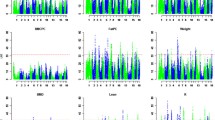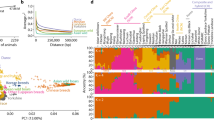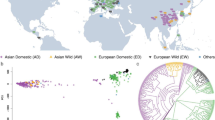Abstract
During the past decade, efforts to map quantitative trait loci (QTL) in pigs have resulted in hundreds of QTL being reported for growth, meat quality, reproduction, disease resistance, and other traits. It is a challenge to locate, interpret, and compare QTL results from different studies. We have developed a pig QTL database (PigQTLdb) that integrates available pig QTL data in the public domain, thus, facilitating the use of this QTL data in future studies. We also developed a pig trait classification system to standardize names of traits and to simplify organization and searching of the trait data. These steps made it possible to compare primary data from diverse sources and methods. We used existing pig map databases and other publicly available data resources (such as PubMed) to avoid redundant developmental work. The PigQTLdb was also designed to include data representing major genes and markers associated with a large effect on economically important traits. To date, over 790 QTL from 73 publications have been curated into the database. Those QTL cover more than 300 different traits. The data have been submitted to the Entrez Gene and the Map Viewer resources at NCBI, where the information about markers was matched to marker records in NCBI’s UniSTS database. Having these data in a public resource like NCBI allows regularly updated automatic matching of markers to public sequence data by e-PCR. The submitted data, and the results of these calculations, are retrievable from NCBI via Entrez Gene, Map Viewer, and UniSTS. Efforts were undertaken to improve the integrated functional genomics resources for pigs.




Similar content being viewed by others
References
Bertram HC, Petersen JS, Andersen HJ (2000) Relationship between RN- genotype and drip loss in meat from Dansh pigs. Meat Science 56: 49-55
Bidanel JP, Rothschild MF (2002) Current status of quantitative trait loci mapping in pigs. Pig News Inf 23(2), N39–N54
Bidanel JP, Milan D, Iannuccelli N, Amigues Y, Boscher MY, et al. (2001) Detection of quantitative trait loci for growth and fatness in pigs. Genet Sel Evol 33(3): 289-309
Casas-Carrillo E, Prill-Adams A, Price SG, Clutter AC, Kirkpatrick BW (1997) Mapping genomic regions associated with growth rate in pigs. J Anim Sci 75(8): 2047-2053
Ciobanu D, Bastiaansen J, Malek M, Helm J, Woollard J, et al. (2001) Evidence for new alleles in the protein kinase adenosine monophosphate-activatedgamma(3)-subunit gene associated with low glycogen content in pig skeletalmuscle and improved meat quality. Genetics 159(3): 1151-1162
de Koning DJ, Janss LL, Rattink AP, van Oers PA, de Vries BJ, et al. (1999) Detection of quantitative trait loci for backfat thickness and intramuscular fatcontent in pigs (Sus scrofa). Genetics 152(4): 1679-1690
de Koning DJ, Rattink AP, Harlizius B, van Arendonk JA, Brascamp EW, et al. (2000) Genome-wide scan for body composition in pigs reveals important role of imprinting. Proc Natl Acad Sci U S A 97(14): 7947–7950
de Koning DJ, Harlizius B, Rattink AP, Groenen MA, Brascamp EW, et al. (2001a) Detection and characterization of quantitative trait loci for meat qualitytraits in pigs. J Anim Sci 79(11): 2812–2819
de Koning DJ, Rattink AP, Harlizius B, Groenen MA, Brascamp EW, et al. (2001b) Detection and characterization of quantitative trait loci for growth and reproduction traits in pigs. Livestock Prod Sci 72(3): 185-198
Fischer GS, Ibrahim M, Brockmann GA, Pahnke J, Bartocci E, et al. (2003) Expression view: visualization of quantitative trait loci and gene-expression data in Ensembl. Genome Biol 4(11), Article R77 (http://www.genomebiology.com/2003/4/11/R77)
Gerbens F, Verburg FJ, Van Moerkerk HT, Engel B, Buist W, et al. (2001). Associations of heart and adipocyte fatty acid-binding protein gene expression with intramuscular fat content in pigs. J Anim Sci 79(2): 347-354
Grindflek E, Szyda J, Liu Z, Lien S (2001) Detection of quantitative trait loci for meat quality in a commercial slaughter pig cross. Mamm Genome 12(4): 299-304
Harlizius B, Rattink AP, de Koning DJ, Faivre M, Joosten RG, et al. (2000) The X chromosome harbors quantitative trait loci for backfat thickness and intramuscular fat content in pigs. Mamm Genome 11(9): 800-802
Hirooka H, de Koning DJ, Harlizius B, van Arendonk JA, Rattink AP, et al. (2001) A whole-genome scan for quantitative trait loci affecting teat number in pigs. J Anim Sci 79(9): 2320-2326
Hu J, Mungall C, Law A, Papworth R, Nelson JP, et al. (2001) The ARKdb: genome databases for farmed and other animals. Nucleic Acids Res 29(1): 106-110
Jeon JT, Carlborg O, Tornsten A, Giuffra E, Amarger V, et al. (1999) A paternally expressed QTL affecting skeletal and cardiac muscle mass in pigs maps to the IGF2 locus. Nat Genet 21(2): 157-158
Knott SA, Marklund L, Haley CS, Andersson K, Davies W, et al. (1998). Multiple marker mapping of quantitative trait loci in a cross between outbred wild boar and large white pigs. Genetics 149(2): 1069-1080
Knott SA, Nystrom PE, Andersson-Eklund L, Stern S, Marklund L, et al. (2002) Approaches to interval mapping of QTL in a multigeneration pedigree: the example of porcine chromosome 4. Anim Genet 33(1): 26-32
Lincoln S (2000) GD.pm interface. The latest versions of GD.pm are available at http://www.stein.cshl.org/WWW/software/GD
Malek M, Dekkers JC, Lee HK, Baas TJ, Rothschild MF (2001a) A molecular genome scan analysis to identify chromosomal regions influencingeconomic traits in the pig. I. Growth and body composition. Mamm Genome 12(8): 630-636
Malek M, Dekkers JC, Lee HK, Baas TJ, Prusa K, et al. (2001b) A molecular genome scan analysis to identify chromosomal regions influencing economic traits in the pig. II. Meat and muscle composition. Mamm Genome 12(8): 637-645
Marklund L, Nystrom PE, Stern S, Andersson-Eklund L, Andersson L (1999) Confirmed quantitative trait loci for fatness and growth on pig chromosome 4. Heredity 82(Pt 2): 134-141
Milan D, Bidanel JP, Iannuccelli N, Riquet J, Amigues Y, et al. (2002) Detection of quantitative trait loci for carcass composition traits in pigs. Genet Sel Evol 34(6): 705-728
Nezer C, Moreau L, Brouwers B, Coppieters W, Detilleux J, et al. (1999) An imprinted QTL with major effect on muscle mass and fat deposition maps to the IGF2 locus in pigs. Nat Genet 21(2): 155-156
Nezer C, Moreau L, Wagenaar D, Georges M (2002) Results of a whole genome scan targeting QTL for growth and carcass traits in a Pietran x Large White intercross. Genet Sel Evol 34(3): 371-387
Ovilo C, Clop A, Noguera JL, Oliver MA, Barragan C, et al. (2002a) Quantitative trait locus mapping for meat quality traits in an Iberian x Landrace F2 pig population. J Anim Sci 80(11): 2801-2808
Ovilo C, Oliver A, Noguera JL, Clop A, Barragan C, et al. (2002b) Test for positional candidate genes for body composition on pig chromosome 6. Genet Sel Evol 34(4): 465-479
Paszek AA, Wilkie PJ, Flickinger GH, Rohrer GA, Alexander LJ, et al. (1999) Interval mapping of growth in divergent swine cross. Mamm Genome 10: 117-122
Perez-Enciso M, Clop A, Noguera JL, Ovilo C, Coll A, et al. (2000). A QTL on pig chromosome 4 affects fatty acid metabolism: evidence from an Iberian by Landrace intercross. J Anim Sci 78(10): 2525-2531
Quintanilla R, Milan D, Bidanel JP. (2002) A further look at quantitative trait loci affecting growth and fatness in across between Meishan and Large White pig populations. Genet Sel Evol 34(2): 193-210
Rathje TA, Rohrer GA, Johnson RK (1997) Evidence for quantitative trait loci affecting ovulation rate in pigs. J Anim Sci 75(6): 1486-1494
Rattink AP, de Koning DJ, Faivre M, Harlizius B, van Arendonk JA, et al. (2000) Fine mapping and imprinting analysis for fatness trait QTLs in pigs. Mamm Genome 11(8): 656-661
Rohrer GA (2000) Identification of quantitative trait loci affecting birth characters and accumulation of backfat and weight in a Meishan-White Composite resource population. J Anim Sci 78: 2547-2553
Rohrer GA, Keele JW (1998) Identification of quantitative trait loci affecting carcass composition in swine: I. Fat deposition traits. J Anim Sci 76(9): 2247-2254
Rohrer GA, Alexander LJ, Hu Z-L, Smith TPL, Keele JW, et al. (1996) A comprehensive map of the porcine genome. Genome Res 6: 371-391
Rohrer GA, Ford JJ, Wise TH, Vallet JL, Christenson RK (1999) Identification of quantitative trait loci affecting female reproductive traits in a multigeneration Meishan-White composite swine population. J Anim Sci 77(6): 1385-1391
Sato S, Oyamada Y, Atsuji K, Nade T, Sato S, et al. (2003) Quantitative trait loci analysis for growth and carcass traits in a Meishan x Duroc F2 resource population. J Anim Sci 81(12): 2938-2949
Schuler GD (1997) Sequence mapping by electronic PCR. Genome Res 7: 541–550
Su YH, Xiong YZ, Zhang Q, Jiang SW, Yu L, et al. (2002a) [Detection of quantitative trait loci for growth in large white x Meishan intercross]. Yi Chuan Xue Bao 29(7): 607-611
Su YH, Xiong YZ, Zhang Q, Jiang SW, Lei MG, et al. (2002b) [Mapping quantitative trait loci for fat deposition in carcass in pigs]. Yi Chuan Xue Bao 29(8): 681-684
Su YH, Ma BY, Xiong YZ (2004) Genetic location of body composition traits in pigs. Hereditas (Beijing) 26(2): 163-166
Szyda J, Liu Z, Grindflek E, Lien S (2002) Application of a mixed inheritance model to the detection of quantitative trait loci in swine. J Appl Genet 43(1): 69-83
Szyda J, Grindflek E, Liu Z, Lien S (2003) Multivariate mixed inheritance models for QTL detection on porcine chromosome 6. Genet Res 81(1): 65-73
Varona L, Ovilo C, Clop A, Noguera JL, Perez-Enciso M, et al. (2002) QTL mapping for growth and carcass traits in an Iberian by Landrace pig intercross: additive, dominant and epistatic effects. Genet Res 80(2): 145-154
Wada Y, Akita T, Awata T, Furukawa T, Sugai N, et al. (2000) Quantitative trait loci (QTL) analysis in a Meishan x Gottingen cross population. Anim Genet 31(6): 376-384
Walling GA, Archibald AL, Cattermole JA, Downing AC, Finlayson HA, et al. (1998) Mapping of quantitative trait loci on porcine chromosome 4. Anim Genet 29(6): 415-24
Walling GA, Visscher PM, Andersson L, Rothschild MF, Wang L, et al. (2000) Combined analyses of data from quantitative trait loci mapping studies. Chromosome 4 effects on porcine growth and fatness. Genetics 155(3): 1369-1378
Wang L, Yu TP, Tuggle CK, Liu HC, Rothschild MF (1998) A directed search for quantitative trait loci on chromosomes 4 and 7 in pigs. J Anim Sci 76(10): 2560-2567
Williams RW, Gu J, Qi S, Lu L (2001) The genetic structure of recombinant inbred mice: High-resolution consensus maps for complex trait analysis. Genome Biol 2(11): 0046.1–0046.18 (http://www.genomebiology.com/2001/2/11/research/0046)
Acknowledgments
The authors thank Drs. Jack Dekkers from Iowa State University, Gary Rohrer from USDA Meat and Animal Research Center (MARC), Andy Law from the Roslin Institute (UK), and Lizhen Wang from Sygen International for their useful discussions in the process of the database design. Thanks also go to Drs. David Adelson from Texas A&M University and Per Johnson from Göteborg University (Sweden) for sharing their materials on cattle and rat QTL database design, respectively. The data for the template chromosome maps are made possible with data mainly from the USDA-MARC comprehensive pig genome map. This work was supported in part by USDA-NAGRP Pig Genome and Bioinformatics Coordination Programs, the Iowa Agriculture and Home Economics Experiment Station, and State of Iowa Hatch funds.
Author information
Authors and Affiliations
Corresponding authors
Rights and permissions
About this article
Cite this article
Hu, ZL., Dracheva, S., Jang, W. et al. A QTL resource and comparison tool for pigs: PigQTLDB. Mamm Genome 16, 792–800 (2005). https://doi.org/10.1007/s00335-005-0060-9
Received:
Accepted:
Published:
Issue Date:
DOI: https://doi.org/10.1007/s00335-005-0060-9




